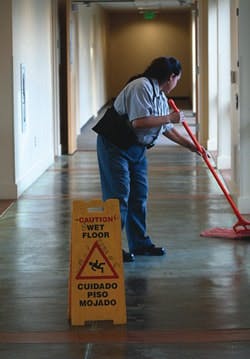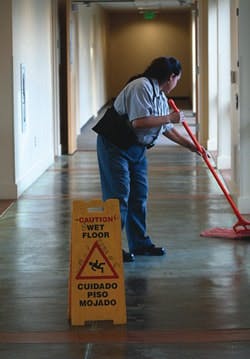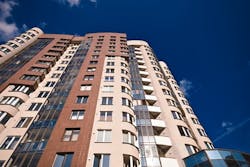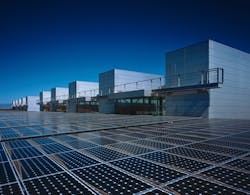Newsworthy
State of the Industry Report Shows Transformation in Commercial Real Estate
Competition for skilled labor, collaborative work practices, and the sustainability wave are all key factors in the future of corporate real estate (CRE), according to the 2008 State of the Industry report from Atlanta-based CoreNet Global. The report is a compilation of the views of industry leaders and research findings from the past year; the data was also compared to CoreNet's 2004 CoRE 2010 benchmarking study.
Richard Kadzis, director of special projects at CoreNet Global and contributor to the study, helps Buildings readers understand the changing industry by answering the following questions.
Buildings: How has CRE transformed since the last study?
Kadzis: The report reflects some big changes since 2004, some of which were unexpected: the velocity and impact of energy management, carbon reduction, and regulatory and other environmental and cost-related CRE-driven initiatives.
New drivers like climate change, the war for talent, mobile technology, location strategies, and flexible workplace practices have either pronounced themselves for the first time or accelerated faster than expected compared to our 2004 baseline.
Buildings: Who will be most affected by this transformation?
Kadzis: Employees will see the biggest changes—in more open and flexible work environments, and more flexible working terms. It's part of a new social contract. Workers will enjoy better working environments while companies realize higher levels of productivity and innovation.
Collaboration is becoming the way that companies innovate, and corporate real estate is playing a big role in leading that transformation. Workplace is key to attracting and retaining talent. Space utilization, mobility, and other alternative workplace practices are hallmarks of sustainability.
Buildings: How have the roles of CRE executives changed or grown?
Kadzis: Companies are increasingly using CRE as a resource for the entire company. CRE executives in-creasingly have a "balcony view" of the enterprise and are solutions providers for the C-suite or business units. But, their ability to partner with other internal shared services, especially HR, is lagging.
The State of the Industry report shows that CRE is less of an order-taker and more of a trusted advisor, and it identifies a number of "sweet spots" where CRE is influencing the direction of the corporate enterprise: sustainability and corporate social responsibility, mergers and acquisitions, emerging markets, workplace practices and work environments, portfolio optimization, and risk management.
Buildings: What business forces are having the greatest impact on the industry?
Kadzis: Macro-economic business forces elevating the leadership role of CRE include:
- Monetization of real estate assets to increase capital and mitigate risk.
- High-speed broadband and wireless technology with secure remote access.
- Advances in smart buildings and mobile and collaborative work.
- A mix of multiple generations in the workplace.
- Sustainably integrated supply-chain practices.
- The war for talent globally and within CRE.
Buildings: What role do CRE executives play in the sustainability wave?
Kadzis: Sustainability rose to the top of the CRE agenda with unprecedented velocity in 2007. We forecasted around the idea of corporate social responsibility in 2004, but never foresaw the impact that energy prices, climate change, and carbon reduction would have today. Our research shows it's only going to get more urgent for most companies. For CRE executives, the main focus that's emerging quickly is energy management.
School districts that contract out transportation, food, and custodial services may want to think twice, according to a report by the East Lansing, MI-based Great Lakes Center for Education Research and Practice.
A Guide to Contracting Out School Support Services: Good for the School? Good for the Community? is based on a review of research and commentary on the practice of contracting out support services. The report includes a series of recommendations directed at school administrators, based on the mixed reviews generally received when support services are contracted out. The recommendations include calling on school officials to closely examine both the decision to contract out and the details of proposed contracts.
The main reason for contracting out—cutting costs—is not always the outcome, according to the report. The authors, Drs. William J. Mathis and Lorna Jimerson, contend that, even when school districts can save money by contracting out services, the practice can also have negative effects, including hidden costs, problems with quality control, greater demands on administrators, social costs to the community, etc.
To view the full policy brief, go to www.greatlakescenter.org.
2030 Blueprint Study Addresses Climate Change
A study released by Santa Fe, NM-based Architecture 2030—the 2030 Blueprint study—shows that an investment of $21.6 billion toward building energy efficiency would replace 22.3 conventional coal-fired plants, reduce CO2 emissions by 86.7 million metric tons, save 204 billion cubic feet of natural gas and 10.7 million barrels of oil, save consumers $8.46 billion in energy bills, and create 216,000 new jobs.
The 2030 Blueprint study gives a comparative analysis of three approaches to addressing climate change—building energy efficiency, "clean" coal (with carbon capture and sequestration), and nuclear power—while laying a new roadmap for solving the global warming and U.S. economic crises. To download the complete study, visit www.architecture2030.org.
Urban Boutique Rental Community Opens in Orange County, CA
The Calypso Apartments and Lofts in Irvine, CA, make up a 177-unit urban boutique rental community that offers a wide variety of floorplans and an architectural design theme that features the casual atmosphere of the Caribbean Islands.
Built by Aliso Viejo, CA-based Shea Properties, the luxury rental community combines an urban feel with a hands-on management team and on-site amenities, like easy access to freeways, work centers, dining, shopping, entertainment, and the beach. Contemporary colors and steel awnings, along with designer finishes—laminate wood flooring, maple cabinetry, stainless-steel appliances, etc.—make these units attractive to urban renters.
DVD Supports Hospital Construction
The Chicago-based American Society for Healthcare Engineering (ASHE) recently announced the launch of Healthcare Construction Television (HCTV). HCTV will grow to be a series of educational videos that provide hospital facility managers with visual resources to help them educate hospital managers and workers on the unique challenges of safely and effectively conducting construction projects within the healthcare environment.
The first DVD in the HCTV series was released in May, titled This New Hospital. The program details the impact that renovation and construction has on a hospital's patients, visitors, and staff. Designed to educate hospital managers and workers who are not generally involved in the construction process, the 30-minute DVD is a training resource for facility managers. For more information, go to www.ashe.org.
National Lighting Bureau Weighs in on CFLs and Mercury
According to John P. Bachner, communications director of the Silver Spring, MD-based National Lighting Bureau, "There's so much misinformation about mercury in compact fluorescent lighting that Americans are being discouraged from using [it]. The overall effect is counterproductive for the nation as a whole. In fact, use of compact fluorescent lamps (CFLs) will result in far less mercury in the environment rather than more."
CFLs can reduce the amount of mercury entering our atmosphere because they use much less electricity than ordinary incandescent bulbs. Most of the nation's electricity is generated by coal-fired power plants; coal combustion releases mercury and other chemicals into the atmosphere. The amount of mercury and other chemicals currently being released into the nation's air to power incandescent lighting could be reduced significantly by simply switching to CFLs.
Although the amount of mercury in the typical CFL can be characterized as tiny, "we still need to be concerned about the proper disposal and recycling of CFLs," says Bachner. He adds that CFL recycling technology is already being used, but that making disposal easier for consumers is the main challenge. The National Lighting Bureau is one of several organizations now working to develop CFL collection centers in every U.S. community. IKEA stores have already agreed to participate, and the U.S. Postal Service is starting an experimental program.
More information, including U.S. Environmental Protection Agency guidance on cleaning up a broken CFL, is available at www.nlb.org.
Clarification
In the June 2008 issue of Buildings, the Airxchange field assembly product line was listed with incorrect contact information. To find out more, please visit www.airxchange.com or call (781) 871-4816.
Energy Consumption Declines While Utility Costs Rise
Led by a dramatic increase in utility costs, the overall cost of running a facility is 10-percent higher than it was just 4 years ago, according to a recent report from the Houston-based Intl. Facility Management Association (IFMA) titled Benchmarks V: Annual Facility Costs.
Based on a survey of 1,032 facility professionals from across North America, the report shows that utility costs (including electricity, gasoline, fuel oil, steam water, and sewage) have jumped 19 percent compared to similar data from 2006. The report shows that average electricity consumption (measured in kBTUs per square foot) has dropped from 93 to 81 while gas consumption has remained constant at 35 kBTUs per square foot. This decrease in energy use could be attributed to companies implementing energy-conservation practices, lighting improvements, and equipment upgrades at their facilities.
Tower 333 Opens on West Coast
A new, 20-story, 415,000-square-foot, Class-A office tower called Tower 333 opened in Bellevue, WA. The first LEED-CS pre-certified office tower on the West Coast, Tower 333 was a collaboration between Seattle-based LMN Architects and Houston-based Hines' CalPERS Green Development Fund (a joint venture between Hines and California Public Employees' Retirement System).
The tower is clad in highly transparent glass that maximizes the site's views west to Lake Washington and the Olympics, south to Mt. Rainier, and east to the Cascades. Natural light is let into the tenant spaces through full-height windows and 10-foot finished ceilings. The building also includes flexible, 23,000-square-foot floorplates, energy-efficient operating systems, and a 0.5-acre outdoor plaza.
"We were asked to design the building around today's knowledge worker, and enjoyed exploring ways to integrate sustainable features, like taller ceiling heights for maximum natural light, or planning the building on less than half the site footprint to create a generous public plaza space," says Walt Niehoff, partner at LMN Architects.
USGBC Testifies Before Congress
The U.S. Green Building Council (USGBC) recently testified before U.S. Congress about the importance of green buildings as a solution for global climate change, one of the biggest challenges facing society today.
The USGBC detailed the impact of the built environment on the natural environment, the economy, and the health and productivity of building users. The testimony also stressed the importance of green-building practices not only in new construction, but also through smart retrofit of existing building stock, with a focus on schools and the role LEED plays in driving the reduction of energy consumption and CO2 emissions.
Michelle Moore, senior vice president, policy and public affairs, at the USGBC, says, "Buildings offer an immediate, measurable solution for mitigating climate change—and we don't have time to wait."
Report Helps Apartments Meet Energy-Efficiency Standards
In an effort to combat climate change, lawmakers at all levels are increasingly looking to apartment owners and developers to improve the energy efficiency of their buildings. A number of proposals introduced in the past year would require apartment properties to exceed existing energy-efficiency requirements (as contained in ASHRAE 90.1) by anywhere from 15 to 50 percent.
The Washington, D.C.-based National Multi Housing Council (NMHC) and the National Apartment Association (NAA) have produced a report to help firms identify the most cost-effective ways to meet mandatory and voluntary energy-efficiency goals. The report, Strategies and Costs to Exceed ASHRAE 90.1-2004 Requirements in a Multifamily Apartment Building, includes information based on extensive energy modeling of a typical apartment property in three U.S. climates to determine what products and practices would be required to exceed existing requirements by 15 percent, 30 percent, and 50 percent, as well as the payback for those investments.
"This is one of the few comprehensive studies examining the costs and feasibility of large increases in energy efficiency for apartments," says Eileen Lee, NMHC/NAA vice president of environment. "As such, not only will it help apartment firms select the most appropriate energy-efficiency investments for their properties, it's also a valuable advocacy tool we can use to help educate policymakers about what is technically feasible and cost effective. For example, the report finds that it will not be possible for most buildings to achieve a 50-percent increase over the ASHRAE 90.1 standard with today's technology."
The report also finds that there are several steps apartment owners can take to significantly improve the energy efficiency of their properties, such as making different water-heating and lighting choices, or incorporating on-site renewable energy generation.
Desert Museum Complex Receives LEED Platinum Rating
The Water + Life Museums complex in Hemet, CA, has received LEED Platinum certification from the U.S. Green Building Council (USGBC), making it the first museum to secure the highest rating bestowed by the USGBC. Comprised of the Center for Water Education and the Western Center for Archeology and Paleontology, the museum was designed by Los Angeles-based Lehrer + Gangi Design + Build.
Despite the harsh desert environment of Hemet (where triple-digit summer heat is the norm and water can freeze in the winter), the 70,000-square-foot complex met the most exacting green standards, including those regarding energy and water consumption. Project costs totaled $40 million, and it spans 17 acres, where indoor and outdoor spaces mix within a framework of open floorplans and lots of natural light.
Topped with one of the largest solar-panel installations of its kind, the museum has many green features: translucent banners hang across 8,000 square feet of deeply recessed, east-facing glass to identify the structures and mitigate the desert sun; heating and cooling are conducted through a sophisticated mechanical system of radiant flooring and forced-air units; and interior lighting, when needed, is controlled by a network of sensors and timers that optimize daylight harvesting.
Newsletter Helps Property Managers Communicate with Tenants to Keep Pests Out
Property managers for multi-family housing facilities can now download a free newsletter from Atlanta-based Orkin Commercial Services to educate tenants on pest management and equip them with practical information to stop infestations before they start.
- Some tips from the newsletter:
- Put away food and clean all dirty dishes. Even food that's been sitting out for only a few hours can attract pests.
- Wipe down counters and other surfaces in the kitchen daily.
- Clean any spills immediately, even if it's just water.
- Remove trash daily and line all trashcans tightly.
- Clean refrigerators weekly and dispose of old food.
- Keep non-perishables tightly sealed, especially sugar, flour, and other items that may not close well in their original packaging.
- Vacuum regularly in cracks and crevices to clean out food that may attract pests. Vacuuming can also eliminate pest allergens and even pests themselves.
The newsletter was created with input from Orkin's board-certified entomologists and can be downloaded at www.orkincommercial.com; select "Property Management" from the drop-down menu under "Industry Solutions."





